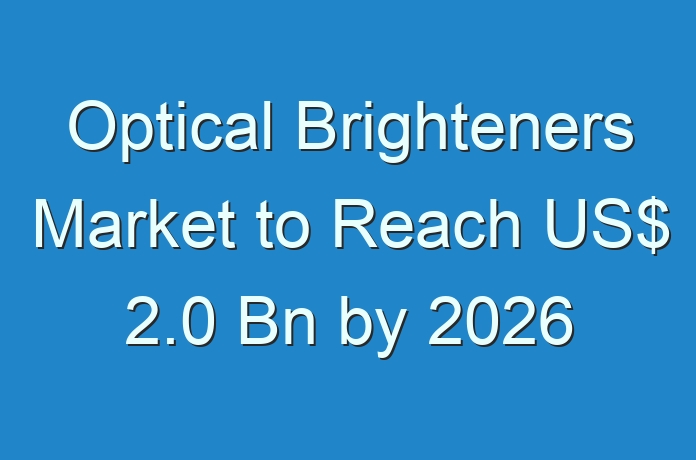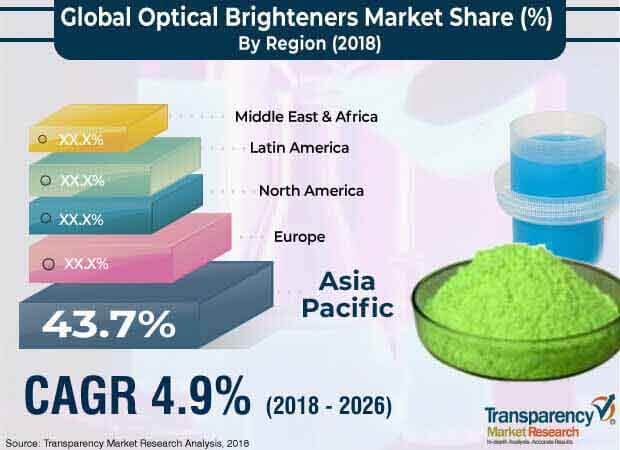
Optical Brighteners Market – Snapshot
Optical brighteners or optical brightening agents are chemicals that are added to plastics, papers, detergents, and textiles for improved reflectance of blue light. Optical brighteners are also known as fluorescent brightening agents or fluorescent whitening agents. They are the chemical compounds that absorb light in the ultraviolet region of the spectrum and re-emit in the blue region by fluorescence. Optical brighteners are primarily used to enhance the appearance of color of papers and fabrics. More than 400 brighteners are available in the color index; however, less than 100 are produced commercially. Addition of high molecular weight polyethylene glycol or polyvinyl alcohol helps improve the performance of optical brighteners. These are hydrophilic water-soluble compounds that are majorly used in laundry detergents.

Request A Sample – https://www.transparencymarketresearch.com/sample/sample.php?flag=S&rep_id=13883
Stilbene, coumarin, diphenyl pyrazoline, and others are the key chemical types of optical brighteners available in the global optical brighteners market. Others includes dicarboxylic acid, and cinnamic acid. The stilbene segment accounts for significant share of the market, as it emits blue rays and provides effective brightness to fabrics. Furthermore, stilbene offers good thermal and chemical resistance. As a result, its fluorescent effect stays for longer duration compared to other types of chemicals. Stilbene is the also first chemical that has been used as optical brightener. Therefore, stilbene chemical is majorly preferred by optical brightener manufacturers.
Optical brighteners are employed in a wide range of applications such as textiles, detergents, papers, cosmetics, plastics, and others (including adhesives and sealants). Detergents was the major application segment of the global optical brighteners market in 2017. Optical brighteners are added to detergents that are used for laundry purposes. Detergent manufacturers are using brightness as a key promotional strategy. This is expected to propel the demand for optical brighteners during the forecast period. Optical brighteners are also used in color-correcting or brightening additives in cosmetics such as shampoos, conditioners, and eye makeup products. Rise in demand for cosmetic products owing to the changing lifestyle is also a prominent factor anticipated to drive the demand for optical brighteners between 2018 and 2026.
Based on chemical, the stilbene segment held major share of more than 70% of the market in terms of volume and value in 2017. Stilbene is also anticipated to be a rapidly expanding segment of the market during the forecast period. It is driven by better chemical properties. It is also employed in a wide range of applications.
More Trending Reports by Transparency Market Research – https://www.prnewswire.com/news-releases/flourishing-construction-sector-to-invite-immense-growth-prospects-for-global-welding-products-market-between-2019-and-2027-tmr-301152083.html
In terms of application, detergents was the prominent segment with more than 25% share of the global optical brighteners market in 2017. It is likely to maintain its dominance between 2018 and 2026. After detergents, textiles is the key application segment of the global optical brighteners market. Detergents and textile are anticipated to exhibit significant growth rate during the forecast period. Rise in demand for laundry care products owing to the increase in standard of living and per capita income of people across the globe is a major factor anticipated to drive the demand for global optical brighteners during the forecast period. Optical brighteners are non-biodegradable chemical and has are toxic in nature. Health hazards associated with optical brighteners, such as allergic reaction to skin and irritation of eyes, are estimated to hamper the global optical brighteners market during the forecast period. Furthermore, shrinking paper industry around the globe owing to rise in usage of smart technologies including laptops, tablets, smart phone is anticipated to hamper the overall demand of optical brighteners during forecast period.
Based on region, Asia Pacific held the leading share of more than 40.0% of the global optical brighteners market in 2017. China is a major country for optical brighteners market. It is the leading manufacturing hub for finished products such as plastics, cosmetics, and laundry care products where optical brighteners are prominently used. Asia Pacific is estimated to maintain its dominance in the global market throughout the forecast period, led by the increase in demand for optical brighteners in textile, detergents, and cosmetic products. The market in Asia Pacific and Latin America is expected to expand at rapid pace, while that in North America and Middle East & Africa is anticipated to expand at sluggish pace between 2018 and 2026.
Request For the Customization – https://www.transparencymarketresearch.com/sample/sample.php?flag=CR&rep_id=13883
The global optical brighteners market is highly fragmented with the presence of regional and local players. Manufacturers are focused on the production of eco-friendly and cost-effective optical brighteners. Prominent players operating in the market are Dayglo Color Corp., Huntsman International LLC., Milliken Chemical, BASF Corporation, Clariant AG, Rudolf GmbH, Aron Universal Limited, Archroma Brand & Performance Textile Specialties, Zhejiang Transfar Whyyon Chemical Co., Ltd, Eastman Chemical Company, Paramount Minerals and Chemicals, Blankophor GmbH& Co. KG, Kolorjet Chemicals Pvt. Ltd., and Meghmani Group. In December 2016, BASF launched a new optical brightener product called Ultraphor RN Plus Liquid. It prevents shade deviation and yellow shades by using non-fixed brighteners.
Request for covid19 Impact Analysis – https://www.transparencymarketresearch.com/sample/sample.php?flag=covid19&rep_id=13883





